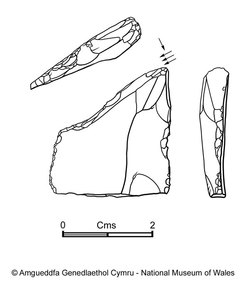Styles and Techniques
When you browse my Portfolio, please bear in mind that each image you see is only one of many possible options. I've posted illustrations and images that reflect a range of styles and methods here, as a starting point for discussing potential commissions.
More frequently now, time and budgetary constraints influence the style and format of the resulting work.
I am often asked to match the style of work created by other illustrators, I am happy to do this wherever necessary.
Full lithic IllustrationI used to create these drawings using ink on drafting film - and still can if required. However, I now trace preliminary work digitally in Adobe software. Each element (outline, ridges, conchoidal fractures) can be put on separate 'layers' for adjustment or reinterpretation.
|
Preliminary DrawingI've included this image to show how the previous illustrations were planned and the level of accuracy involved.
This drawing was created using blue pencil on drafting film and approved by the client before digitising in black and white. This step can be omitted if necessary (I can draw directly over my own photographs on the computer) but may be useful for complex interpretations (saving time in the long run). |
Annotated photographThis is not necessarily the best option for flints but is commonly used for many other small finds.
I am happy to take photographs specifically for this type of output and edit them for publication. I can also edit archive photographs if suitable. This is a speedy and cost effective technique. |
Reflectance Transformation Imaging (RTI)Please see my blog for more pictures and details of this useful and efficient technique. The main output for this service is an RTI file. This allows the user to zoom in on an image of the object and view surface details under different lighting angles whilst applying various rendering options to bring out detail and surface features. A full explanation and software can be found at the excellent Cultural Heritage Imaging website.
|
Annotated drawingDrawings in blue pencil on drafting film used to be a an unpublished preliminary to the ink version. Blue pencil was used so that the new tracing in ink could easily be seen against the sketch underneath.
Digital editing and printing techniques mean that the original drawing (rendered as a grey scale and annotated in Adobe products) can now be used if desired. The drawing inherently contains more detail than the same image rendered as ink-pen dots. The expense and relative inflexibility of printing techniques in previous decades were amongst the main drivers for some of the line and stipple techniques used in traditional archaeological illustration. |
'Stipplette'This is one of several images of Medieval stone-work created specifically in order to match archive material (ink stipple on drafting film or paper).
Time would not allow for the same, traditional technique to be used. So this is a photograph, manipulated in Adobe Photoshop and combined with stipple extracted from my own work. A much quicker alternative. When I showed this method to my illustration colleague, he dubbed it 'stipplette'. |
3D ModellingI've been experimenting with computer generated photogrammetric modelling since around 2002. I now use Agisoft PhotoScan to create images like this (displayed as a 2D screen-grab here).
I've also used a NextEngine desktop laser scanner (see a comparison in my Portfolio). I use Meshlab for editing purposes but have also used 3DS Max. I will be doing more experiments like this in order to plan a sensible workflow, I'll post the results on this website. |
Maps and plansIt's a long time since anyone used drafting film for this type of work.
This image was created using Illustrator and Photoshop. I have been trained in the use of ESRI's ArcGIS software and currently use QGIS. |
Full colour workI can work from excavation reports, photographs, sketches and my clients' ideas in order to make new images of familiar sites and objects.
This is a 'half' reconstruction (from excavation plans and photographs) of Pentre Ifan chambered tomb. It was created to show the horizontal extent of the cairn, surrounding landscape, and speculative reinstatement of megaliths. |













